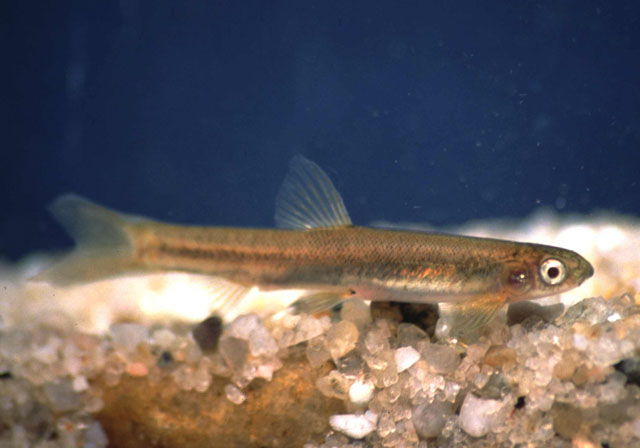| Kneriidae (Shellears) |
| 7 cm SL (male/unsexed); max. reported age: 3 years |
|
benthopelagic; freshwater, potamodromous |
| Africa: most mountain and plateau tributaries of the Zambezi, Pungwe, Buzi, Sabi/Save and Runde/Lundi rivers (Ref. 83372) in Zimbabwe, Zambia and Mozambique. Also in the upper Congo River basin (Lualaba, upper Lualaba, Lake Mweru and Luapula) (Ref. 45616) in Democratic Republic of the Congo and Zambia. A relict southern pocket occurs in the Crocodile (Incomati system), Transvaal (Ref. 7248, 52193). Identity of specimens from the Kafue and upper Zambezi requires confirmation (Ref. 52193). Not recorded from coastal areas (Ref. 5214). |
|
Dorsal spines (total): -0; Dorsal soft rays (total): 9-10; Anal spines: -0; Anal soft rays: 8-11. Description: body cylindrical, slightly humped at mid-body (Ref. 5214, 12524), well covered with mucus (Ref. 5214). Body depth equals head length, 4.5 times in standard length; eye diameter 3 times in head length; jaws without teeth, lower jaw with sharp cutting edge; eyes lateral, visible from below and above (Ref. 88972). Head smooth, rounded; mouth ventral, bow-shaped (Ref. 6385, 52193). Dorsal fin with 2-3 unbranched and 7-9 branched rays, anal with 3 unbranched and 6-8 branched rays; pectoral fin with 14-15 rays (Ref. 52193, 88972, 88973). No enlarged scale at base of pelvic fins (Ref. 88972). Dorsal fin situated above pelvic fin base (Ref. 42135, 45616), or pelvic fin base slightly in front of dorsal fin base (Ref. 13721). Dorsal fin placed equidistant between anterior margin of eye and end of scaly process on caudal peduncle (Ref. 6385, 12524). Scales minute (Ref. 6385). Number of lateral line scales very variable (60-100) and population dependent (Ref. 13721, 42135, 45616). Lateral line arched to avoid opercular organ/contact organ (Ref. 52193). Opercular apparatus only in males; males more elongated than females (Ref. 41590). Colouration: Body yellowish grey (Ref. 88972), mottled with dark blotches (Ref. 13721, 52193) above the thin, dark lateral stripe (Ref. 13721, 52193, 88972) which is located on trunk and caudal peduncle (Ref. 52193). A few small dark blotches on the lateral line towards the caudal peduncle (Ref. 13721). Upper parts of body darker; minute black dots, more or less distinct, at the base of dorsal, anal and pelvic fins; ventral side of head and caudal peduncle whitish (Ref. 88972). Some specimens with dark spot at base of ventral and anal fins (Ref. 13721). Dark spot at base of pelvic and pectoral fins (Ref. 52193).
Description: details on skull osteology, digestive tract, pectoral girdle and structure of epibranchial and opercular organs can be found in Ref. 88973. |
| Usually found in small headwater streams with fast water associated with rapids and a boulder stream floor, with or without aquatic vegetation (Ref. 12524). Shoals occur in pools of small, clear, silt-free, rocky streams; reported to breathe air and to climb over damp rocks and up the sides of waterfalls during migrations (Ref. 13721, 52959). Can tolerate living out of the water for a long time if conditions are damp (Ref. 246, 5214, 13721). Scrapes diatoms, algae, and detritus from rock surfaces and also takes small aquatic insects such as mayfly nymphs and midge larvae; matures after a year; breeds in spring and summer, larger females bear up to 600 eggs (Ref. 52959). Moves on to flooded grasslands during the rainy season (Ref. 12524, 13337). Males and females have been observed swimming together, apparently joined side by side by means of the males' opercular disc (Ref. 12524). |
|
Least Concern (LC); Date assessed: 01 May 2009 Ref. (130435)
|
| harmless |
Source and more info: www.fishbase.org. For personal, classroom, and other internal use only. Not for publication.

